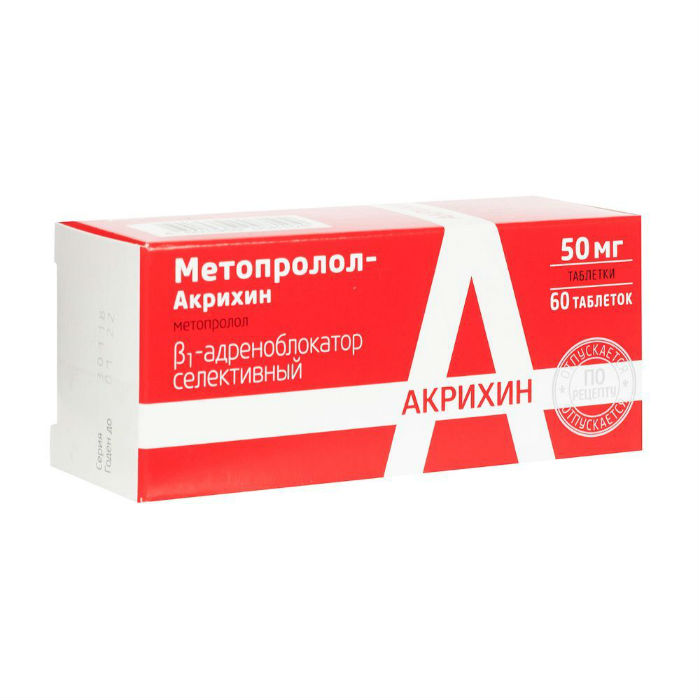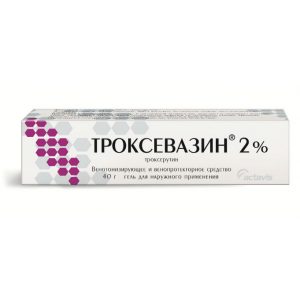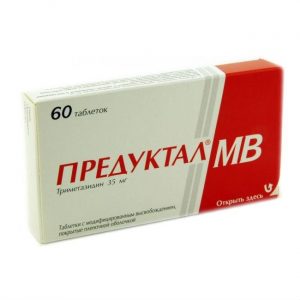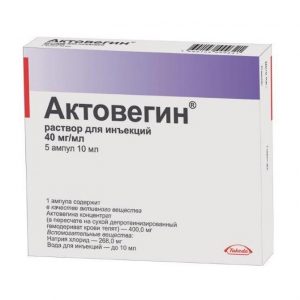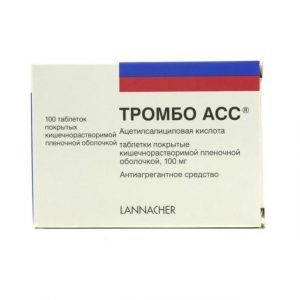Description
Pharmacological action
Metoprolol refers to cardioselective beta-adrenergic blockers, not possessing internal sympathomimetic activity and membrane stabilizing properties. It has hypotensive, antianginal and antiarrhythmic effects. Blocking beta1-adrenergic receptors of the heart in low doses, it reduces the formation of cAMP stimulated by catecholamines from ATP, reduces the intracellular current of calcium ions, has a negative chrono-, dromo-, batmo- and inotropic effect (reduces heart rate, inhibits conduction and excitability, reduces myocardial contractility).
The total peripheral resistance at the beginning of the use of beta-blockers (in the first 24 hours after ingestion) – increases (as a result of a reciprocal increase in the activity of alpha-adrenergic receptors and the elimination of beta2-adrenergic receptor stimulation), which returns to the initial one after 1-3 days, and when prolonged use is reduced.
The antihypertensive effect is due to a reflex decrease in cardiac output and renin synthesis, inhibition of the activity of the renin-angiotensin-aldosterone system (more important in patients with initial hypersecretion of renin) and the central nervous system, and restoration of the sensitivity of the aortic arch baroreceptors (there is no increase in their activity in response to decrease in blood pressure) and, as a result, a decrease in peripheral sympathetic influences. Reduces elevated blood pressure at rest, with physical exertion and stress. The antihypertensive effect develops rapidly (systolic blood pressure decreases after 15 minutes, maximum – after 2 hours) and lasts for 6 hours, diastolic blood pressure changes more slowly: a stable decrease is observed after several weeks of regular use.
The antianginal effect is determined by a decrease in myocardial oxygen demand as a result of a decrease in heart rate (lengthening diastole and improved myocardial perfusion) and contractility, as well as a decrease in the sensitivity of the myocardium to the effects of sympathetic innervation. Reduces the number and severity of angina attacks and increases exercise tolerance.
Antiarrhythmic effect is due to the elimination of arrhythmogenic factors (tachycardia, increased activity of the sympathetic nervous system, increased content of cAMP, arterial hypertension), a decrease in the rate of spontaneous excitation of sinus and ectopic pacemakers and a slowdown in AV conduction (mainly in antegrade and, to a lesser extent, in retrograde directions) through the AV node and along additional paths.
With supraventricular tachycardia, atrial fibrillation, sinus tachycardia with functional heart diseases and hyperthyroidism, reduces heart rate, or even can lead to restoration of sinus rhythm.
Prevents the development of migraines. When used in medium therapeutic doses, unlike non-selective beta-blockers, it has a less pronounced effect on organs containing beta2-adrenergic receptors (pancreas, skeletal muscle, smooth muscles of the peripheral arteries, bronchi and uterus) and on carbohydrate metabolism. When used in large doses (more than 100 mg / day), it has a blocking effect on both subtypes of beta-adrenergic receptors.
Indications
arterial hypertension (as monotherapy or in combination with other antihypertensive agents)
coronary heart disease: myocardial infarction (secondary prophylaxis – complex therapy), prevention of angina pectoris
cardiac arrhythmias (supraventricular ventricular) therapy)
prevention of migraine attacks.
Contraindications
cardiogenic shock
atrioventricular block (AV) II-III degree
sinoatrial (SA) blockade
sinus syndrome weakness
severe bradycardia
ardnitsa heart disease chronic arterial disease chronic heart disease myocardial infarction – systolic blood pressure less than 100 mm Hg, heart rate less than 45 beats / min)
lactation period
simultaneous administration of MAO inhibitors or simultaneous intravenous administration s verapamil
age of 18 years (effectiveness and safety have not been established)
lactose intolerance, lactase deficiency or glucose-galactose malabsorption.
hypersensitivity to metoprolol or other components of the drug, other beta-blockers
Precautions: diabetes mellitus, metabolic acidosis, bronchial asthma, chronic obstructive pulmonary disease (emphysema, chronic obstructive bronchitis), peripheral vascular disease (intermittent claudication, Raynaud’s syndrome), chronic liver and / or renal failure, myasthenia gravis, pheochromocytoma (with the simultaneous use of alpha-blockers), AV block I degree, thyrotoxicosis, depression (including history), psoriasis, pregnancy, old age.
Special instructions
Monitoring patients with beta-blockers includes regular monitoring of heart rate and blood pressure, blood glucose in patients with diabetes. If necessary, for patients with diabetes mellitus, the dose of insulin or hypoglycemic agents prescribed orally should be selected individually.
The patient should be trained in the method of calculating heart rate and instructed on the need for medical advice for heart rate less than 50 beats / min. When taking doses above 200 mg per day, cardioselectivity decreases.
In heart failure, treatment with metoprolol begins only after the compensation stage has been reached.
It is possible to increase the severity of hypersensitivity reactions (against the background of a burdened allergic history) and the lack of effect from the administration of usual doses of epinephrine (adrenaline).
May aggravate symptoms of peripheral arterial circulatory disorders. Drug withdrawal is carried out gradually, reducing the dose within 10 days. With a sharp cessation of treatment, withdrawal syndrome may occur (increased angina attacks, increased blood pressure).
Particular attention when discontinuing the drug must be given to patients with angina pectoris. With angina pectoris, the selected dose of the drug should provide a resting heart rate within 55-60 beats / min, with a load of no more than 110 beats / min.
Patients using contact lenses should take into account that tear fluid production may be reduced during treatment with beta-blockers. Metoprolol may mask some clinical manifestations of hyperthyroidism (e.g., tachycardia). Abrupt withdrawal in patients with thyrotoxicosis is contraindicated, since it can enhance symptoms.
With diabetes, it can mask tachycardia caused by hypoglycemia. Unlike non-selective beta-blockers, it practically does not enhance insulin-induced hypoglycemia and does not delay the restoration of blood glucose concentrations to normal levels.
If necessary, the appointment of patients with bronchial asthma, as a concomitant therapy using beta2-adrenergic agonists with pheochromocytoma – alpha-blockers.
If surgical intervention is necessary, it is necessary to warn the anesthesiologist about the therapy (the choice of a means for general anesthesia with minimal negative inotropic effect), drug withdrawal is not recommended. Drugs that reduce the reserves of catecholamines (for example, reserpine) can enhance the effect of beta-blockers, so patients taking such combinations of drugs, should be under the constant supervision of a doctor to detect an excessive decrease in blood pressure and bradycardia.
In elderly patients, regular monitoring of liver function is recommended. Correction of the dosing regimen is required only in the case of an elderly patient with increasing bradycardia (less than 50 beats / min), a pronounced decrease in blood pressure (systolic blood pressure below 100 mm Hg), atrioventricular block, bronchospasm, ventricular arrhythmias, severe liver dysfunction It is sometimes necessary to discontinue treatment.
Patients with severe renal impairment are advised to monitor renal function.
Special monitoring of the condition of patients with depressive disorders taking metoprolol in the event of depression caused by taking beta-blockers, it is recommended to stop therapy.
Due to the lack of sufficient clinical data, the drug is not recommended for use in children.
Effect on the ability to drive vehicles and control mechanisms
At the beginning of treatment with metoprolol, patients may experience dizziness, fatigue. In this case, they should refrain from driving vehicles and engaging in potentially dangerous activities that require increased concentration of attention and speed of psychomotor reactions. In the future, the determination of dose safety is carried out individually.
Composition
1 tab. contains:
Active ingredients:
metoprolol – 50 mg
Excipients:
lactose monohydrate,
silicon dioxide colloid,
potato starch,
povidone,
carboxymethyl starch sodium,
Dosage and administration
Tablets are taken orally during or immediately after a meal, do not chew, drink a small amount of liquid.
Arterial hypertension
The initial daily dose is 50-100 mg in 1-2 doses (morning and evening). With an insufficient therapeutic effect, the daily dose can be gradually increased to 100-200 mg and / or additional prescription of other antihypertensive agents. The maximum daily dose of 200 mg.
Angina pectoris, arrhythmias, prevention of migraine attacks
100-200 mg per day in two divided doses (morning and evening).
Secondary prevention of myocardial infarction
200 mg per day in two divided doses (morning and evening).
Hyperthyroidism
50 mg 2 times a day (morning and evening).
In elderly patients, with impaired renal function, as well as with the need for hemodialysis, the dose is not changed. In case of impaired liver function, the dose should be reduced depending on the clinical condition.
Side effects
From the central nervous system: fatigue, weakness, headache, slowing down the rate of mental and motor reactions rarely – paresthesia in the extremities (in patients with intermittent claudication and Raynaud’s syndrome), depression, anxiety, decreased attention, drowsiness, insomnia, nightmares, confusion or short-term memory impairment, muscle weakness.
On the part of the sensory organs: rarely – decreased vision, decreased secretion of lacrimal fluid, dry and sore eyes, conjunctivitis, tinnitus.
From the cardiovascular system: sinus bradycardia, palpitations, decreased blood pressure, orthostatic hypotension (dizziness, sometimes loss of consciousness) rarely – decreased myocardial contractility, temporary worsening of symptoms of chronic heart failure (edema, swelling of the feet and / or lower legs, shortness of breath), arrhythmias, manifestation of angiospasm (increased disturbance of peripheral circulation, cooling of the lower extremities, Raynaud’s syndrome), impaired myocardial conduction.
From the digestive system: nausea, vomiting, abdominal pain, dry mouth, diarrhea, constipation, taste change.
From the skin: urticaria, pruritus, rash, exacerbation of psoriasis, psoriasis-like skin reactions, hyperemia of the skin, exanthema, photodermatosis, increased sweating, reversible alopecia.
From the respiratory system: nasal congestion, difficulty breathing out (bronchospasm when prescribed in high doses – loss of selectivity and / or in predisposed patients), shortness of breath.
From the endocrine system: hypoglycemia (in patients receiving insulin) rarely – hyperglycemia (in patients with insulin-dependent diabetes mellitus).
Lab performance: rarely – thrombocytopenia (unusual bleeding and hemorrhage), agranulocytosis, leukopenia, increased activity of liver enzymes, very rarely – hyperbilirubinemia.
Influence on the fetus: intrauterine growth retardation, hypoglycemia, and bradycardia are possible.
Other: pain in the back or joints, like all beta-blockers, in rare cases can cause a slight increase in body weight, decreased libido and / or potency.
Overdose of
Symptoms:
severe severe sinus bradycardia, dizziness, nausea, vomiting, cyanosis, marked decrease in blood pressure, arrhythmia, ventricular extrasystole, bronchospasm, fainting, with acute overdose – cardiogenic shock, loss of consciousness, coma, atrioventricular block (up to the development of complete transverse blockade and cardiac arrest), cardialgia.
The first signs of an overdose appear 20 minutes to 2 hours after taking the drug.
Treatment:
gastric lavage and adsorbing agents symptomatic therapy: with a pronounced decrease in blood pressure – the patient should be in the Trendelenburg position in case of excessive decrease in blood pressure, bradycardia and heart failure – iv, with an interval of 2-5 minutes, beta -adrenomimetics – until the desired effect is achieved or in / in 0.5-2 mg of atropine sulfate. In the absence of a positive effect – dopamine, dobutamine or norepinephrine (norepinephrine).
As a follow-up, perhaps the introduction of 1-10 mg of glucagon, the installation of a transvenous intracardial electrostimulator. With bronchospasm, intravenous beta2-adrenergic agonists should be administered. Metoprolol is poorly excreted by hemodialysis.
Storage conditions
In a dry, dark place at a temperature of no higher than 25 ° C.
Keep out of the reach of children.
Expiration
4 years.
Deystvuyuschee substances
Metoprolol
Terms and conditions
prescription
Dosage form
tablets
